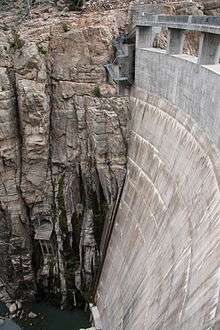Shoshone River
| Shoshone River (Aashilitshia, "Stinking River" Aashbikkaashée, "Grass Lodge [Shoshone] River") [1]) | |
| River | |
| South Fork Shoshone River in Park County, Wyoming, 1923. | |
| Country | United States |
|---|---|
| State | Wyoming |
| Cities | Cody, Wyoming, Powell, Wyoming, Lovell, Wyoming |
| Source | |
| - location | Absaroka Range, Wyoming |
| - coordinates | 44°30′04″N 109°11′02″W / 44.50111°N 109.18389°W [2] |
| Mouth | Big Horn River |
| - location | Lovell, Wyoming |
| - coordinates | 44°51′44″N 108°12′17″W / 44.86222°N 108.20472°WCoordinates: 44°51′44″N 108°12′17″W / 44.86222°N 108.20472°W [2] |
| Length | 100 mi (161 km) |
| Basin | 2,989 sq mi (7,741 km2) |
| Discharge | for below Buffalo Bill Dam |
| - average | 1,037 cu ft/s (29 m3/s) |
| - max | 17,300 cu ft/s (490 m3/s) |
| - min | 59 cu ft/s (2 m3/s) |
 Map of the Bighorn River basin including the Shoshone River | |
The Shoshone River is a 100-mile (160 km) long river in northern Wyoming in the United States. Its headwaters are in the Absaroka Range in Shoshone National Forest. It ends when it runs into the Big Horn River near Lovell, Wyoming. Cities it runs near or through are Cody, Powell, Byron, and Lovell. Near Cody, it runs through a volcanically active region of fumaroles known as Colter's Hell.[3] This contributed to the river being named on old maps of Wyoming as the Stinking Water River.
The current name was established in 1901 due to popular demand.[2]

West of Cody the river is impounded in Shoshone Canyon by the Buffalo Bill Dam, created as part of the Shoshone project; one of the nation's first water conservation projects. A number of hot springs along the Shoshone were drowned by the reservoir.[3] Upstream of Buffalo Bill Reservoir the Shoshone splits into the North Fork, which follows a long canyon down from the Absaroka Mountains to the vicinity of the east entrance of Yellowstone National Park, and the South Fork, which originates at the southern end of the Absarokas.
See also
- Mummy Cave, an alcove eroded into a cliff face by the North Fork of the Shoshone that has yielded evidence of 9000 years of occupation
- Shoshonite
References
- ↑ "Little Big Horn College Library". Retrieved 2012-06-05.
- 1 2 3 U.S. Geological Survey Geographic Names Information System: Shoshone River, USGS GNIS
- 1 2 Mattes, Merrill J. (1962). "Chapter IV: "Colter's Hell": A Case of Mistaken Identity". Colter's Hell and Jackson's Hole. Yellowstone Association & Grand Teton Natural History Association. Retrieved 2009-07-29.
